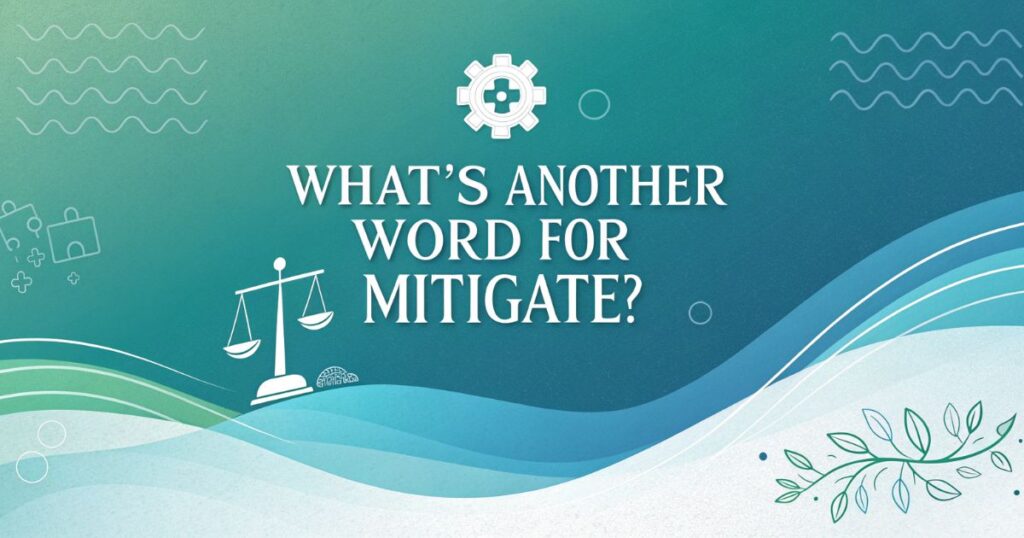Picture this: Your biggest client just threatened to cancel their contract, your teenager crashed the family car, or a natural disaster is heading straight for your hometown.
In each scenario, you’re not looking to eliminate the problem—you need to reduce its impact. That’s precisely where mitigation becomes your most valuable skill.
Understanding mitigation transforms reactive people into strategic problem-solvers who minimize damage before it spirals out of control.
This comprehensive guide reveals everything you need to master this essential concept, from boardroom discussions to family dinner table conversations.
What Does “Mitigate” Actually Mean? Breaking Down the Definition
Mitigation means making something less severe, harmful, or painful without completely eliminating it. Think of it as turning down the volume on life’s problems rather than hitting the mute button entirely.
The word traces back to the Latin “mitigatus,” which literally means “to soften.” However, modern usage has evolved far beyond this simple translation. Effective mitigation requires understanding timing, context, and the delicate balance between action and restraint.
What’s Another Word for Mitigate?

When you need everyday alternatives, “reduce” serves as the most straightforward replacement. It’s universally understood and works in virtually every context where mitigation applies.
“Lessen,” “ease,” and “alleviate” each carry subtle distinctions. “Lessen” sounds more casual, “ease” implies comfort or relief, while “alleviate” adds sophistication to professional communications. Choose based on your audience and the severity of the situation you’re addressing.
The Best Mitigation Meaning
In business environments, mitigation typically involves strategic risk management. Companies mitigate supply chain disruptions by diversifying suppliers, or mitigate customer complaints through proactive service recovery programs.
Legal contexts showcase mitigation’s most precise usage. Mitigating circumstances in court proceedings don’t excuse criminal behavior—they potentially reduce penalties. Similarly, environmental mitigation requirements don’t prevent development but mandate offsetting ecological damage through restoration projects elsewhere.
Mitigation in Action Real-World Examples
Consider how Southwest Airlines mitigates flight delays. They don’t prevent weather delays, but they minimize passenger frustration through transparent communication, rebooking assistance, and compensation programs. This proactive approach transforms potential PR disasters into customer loyalty opportunities.
In personal finance, emergency funds represent classic mitigation strategy. You can’t prevent job loss or medical emergencies, but maintaining three to six months of expenses significantly reduces their financial impact. Smart families also mitigate healthcare costs through preventive care and appropriate insurance coverage.
Practical Applications for Americans
Workplace communications benefit from precise mitigation language. Instead of saying “we’ll fix this problem,” try “we’ll mitigate the impact while developing permanent solutions.” This demonstrates strategic thinking and realistic expectations.
Personal relationships require different approaches. When apologizing, acknowledge that you can’t undo your actions but explain specific steps to mitigate future harm. This shows responsibility and forward-thinking rather than empty promises about changing the past.
Mitigation Strategies That Work
Successful mitigation requires three components: early identification, proportional response, and stakeholder communication. The earlier you recognize potential problems, the more options you have for reducing their impact.
Industry leaders understand that mitigation costs money upfront but saves exponentially more later. Netflix mitigates content licensing risks by investing in original programming. This strategy costs billions initially but provides complete control over their most valuable assets.
How Americans Use “Mitigate” Differentl
Regional variations across America reflect different cultural priorities. East Coast professionals favor mitigation in legal and financial contexts, while West Coast tech companies emphasize risk mitigation in product development and user experience design.
Government agencies use mitigation most formally, particularly in disaster preparedness and environmental policy. FEMA’s mitigation programs help communities reduce future disaster damage through building codes, flood control, and infrastructure improvements.
FAQ Section
What is the definition of mitigate?
Mitigate means to make something less severe, serious, or painful. It involves reducing negative impact rather than eliminating problems entirely. For example, wearing a seatbelt mitigates injury risk in car accidents without preventing crashes.
What is a simple word for mitigate?
“Reduce” is the simplest alternative to mitigate. Other options include “lessen,” “ease,” “minimize,” and “alleviate.” Choose based on context: use “reduce” in casual conversation, “alleviate” in professional settings, and “ease” when describing comfort or relief.
What is the best mitigation meaning?
The best mitigation meaning depends on context. In business, it’s strategic risk management. In legal settings, it’s penalty reduction through circumstantial evidence. In personal life, it’s damage control that preserves relationships and minimizes consequences.
Conclusion
Understanding mitigation empowers you to handle life’s inevitable challenges with strategic precision rather than panic.
Whether you’re managing corporate crises or family emergencies, the ability to reduce impact transforms problems from disasters into manageable situations. Master this concept, and you’ll find yourself better equipped to navigate uncertainty with confidence and effectiveness.
More Posts
Copacetic Meaning, Definition, Common Usage, and Synonyms
1111 Meaning: Angel Number 1111 and the Idea of Pause
AFK Meaning: The Essential Guide to Understanding and Applying AFK

Welcome to Brightnis! I am the admin and creator of this platform. I love questioning ideas and exploring different situations. My goal is to encourage critical thinking and help people see things from new perspectives. Join me in discussing thought-provoking topics and finding unique solutions to everyday challenges!






